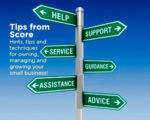Branded Signage
 Question: We use signage in our retail store windows, on our counters and out in the community to attract buyers to our store. What are some keys to creating high impact signage?
Question: We use signage in our retail store windows, on our counters and out in the community to attract buyers to our store. What are some keys to creating high impact signage?
Answer: Be bold and concise. Make your signage copy easy to read from 10-15 feet away so that the 3 seconds customers give to take in messages on signs, placards and poster achieve its goal. But, be consistent with the remainder of your branded messages. All your communications should have the same look and feel and deliver the same visual impression regardless of the medium or vehicle. Your website, Linked-in entry, Facebook page, and all promotional materials should be visually integrated.
Placement is crucial. Your signs and posters need to be where buyers will see them without assistance. Start with signage in the parking lot on light posts. Make your storefront posters visible from the street or sidewalk. Your in-store signage can be used to guide visitors to where you want them to notice and buy featured products. Signage also can act as a substitute for your sales attendants who are busy with other customers. A word from the experienced retailers: make sure you understand your town’s rules and regulations regarding signage and posters.
Highlight your differentiators. Show how you compare to your competitors. People buy out of differentiation, so make sure your customers know why they should buy from you and not your competitor. “Money back guarantee. No questions”. “Fully assembled, delivered with a full tank, your old gas grill removed and the first-year service free.”
Make sure your call to action is prominent. Buyers need to know without exerting much energy to know what you are offering them. Use action words to which your customers can relate. “Take advantage of this limited time offer.” “Two dinners for $19.95 with a glass of wine, eaten on premises.” “Buy now! Sale ends Saturday at 6 pm.” To generate impact, tell stories. If you are featuring an artist’s or craftsman’s work, give a short biography or story about the creator or creation. Try having your employees tell stories about products through signage. If young women’s clothing or accessories, have sales personnel who use and are wearing individual pieces tell their story reinforced through signage.
Test the impact. Train your staff to ask everyone who comes in: (1) Have you purchased here in the past? If so, “welcome back” (2) If not, how did you hear about us? You can determine what tools are working best. Is it the signage in your parking lot or window that stopped buyers? Is it the advertisement you ran in the Cape Cod Times that caught their attention? Was it a radio spot? Or was it the direct mailer you sent last week? When you know what is working, you can do it again.
Attract attention. Buyers are bombarded with marketing images and breaking through the blur of messaging is vital to the success of your campaign. Big, bold, clear fonts that are easy to read captures visitor attention. Colors that are bright and bold captures buyer interest.
Promote your brand by displaying your logo, your tagline and remind buyers of who you are, what you do and what you offer.
Your signage communicates your brand. Your brand lives in the mind of the buyer and how you communicate reinforces that brand perception. After you have generated your signage test it with someone who can address how your brand is communicated. If it tests positive, move forward. If not, modify your “voice” to reflect your brand image.











